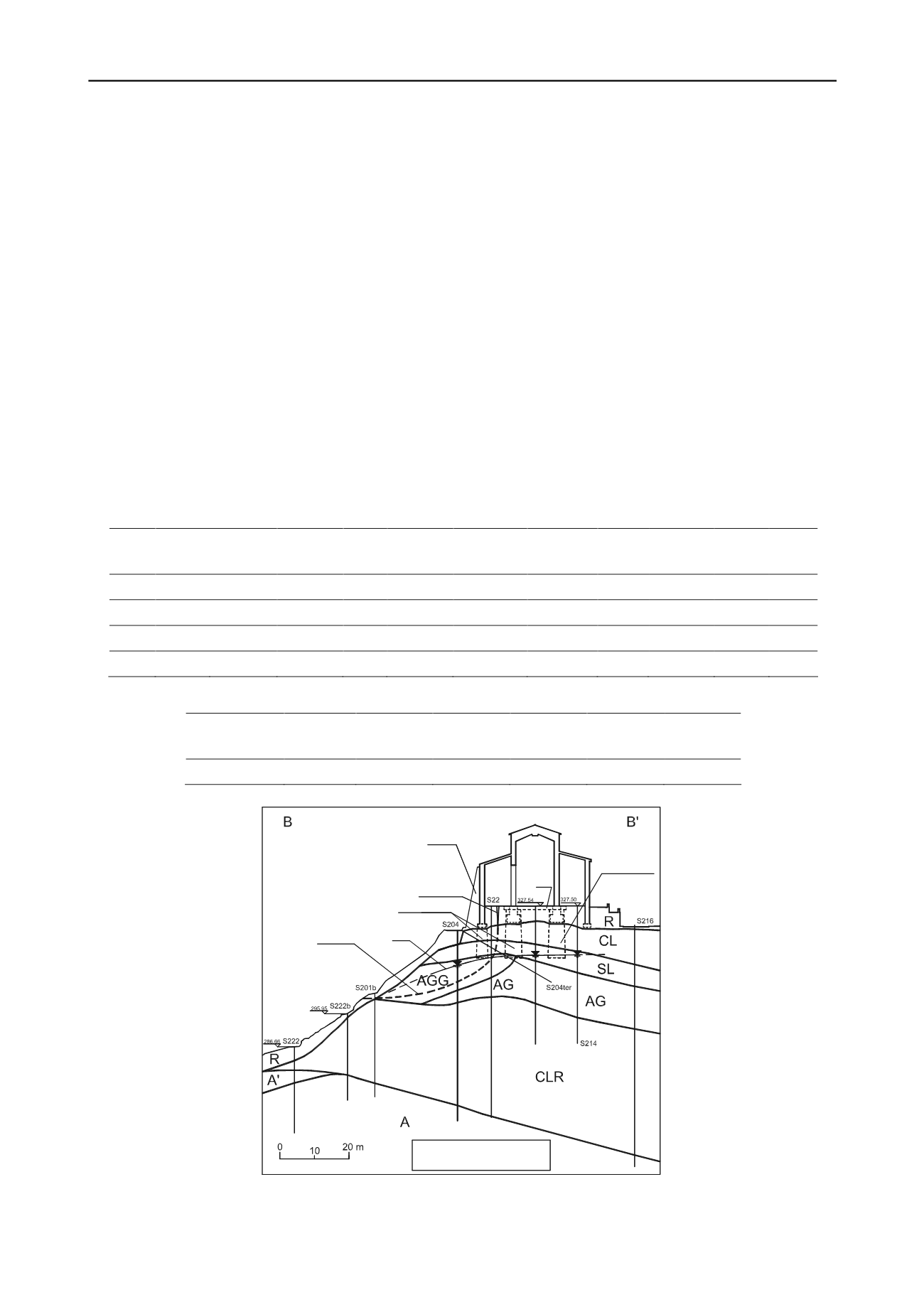
3143
Technical Committee 301 /
Comité technique 301
CL,whilst the northern wall and a small stretch of western
(facade) wall rest on intensely fractured calcarenites or on
silty sands SL, see Fig. 2. The columns have been
underpinned by groups of fourteen “root piles” about 15 m
long, slightly inclined to the vertical so to describe a ruled
surface flaring downwards (Lizzi, 1993). Each root pile was
reinforced with a single, 24 mm diameter, steel bar. Shorter
root piles were used to underpin the northern wall of the
Cathedral. Root piles groups under the nave columns have
been tied at the top by a grid of reinforced concrete beams. It
is clear from Fig. 2 that the foundation ground of the
Cathedral is far from uniform and that the thickness of the soft
calcarenite layer CL diminishes or vanishes as the northern
slope is approached. During the underpinning works in 1976-
1980 it was ascertained that the CL calcarenite layer was
dissected by a long and deep fracture (or tension crack)
located inside the Cathedral near the northern wall, as shown
in figures 1 and 2; it was “stitched” by cement pressure
grouting.
7 GROUND MOVEMENTS, FISSURATION PATTERN
OF THE CATHEDRAL AND CAUSES OF ITS
UNSATISFACTORY BEHAVIOUR
The most striking sign of ground movement is a
longitudinal subvertical tension crack running in East-West
direction through the floor of the northern aisle, and extending
continuously to the parvis, the staircase and the Don Minzoni
square, and in the opposite direction to the apse, the
archiepiscopal palace and the Ismani Hypogeum as shown in
Fig.1. This fracture has been firstly surveyed by Commissione
del Ministero dei Lavori Pubblici for the investigation of the
great
“
Addolorata landslide
”
(1968). The aperture of this
fracture exceeds more than 20 centimeters in the Ismani
hypogeum. After the restoration works completed in 2000, the
fracture formed again in the Cathedral floor and in the parvis;
its aperture slowly progresses and has now attained 4 cm.
There is a step, from 2 to 3 cm high, between the northern and
the southern walls of the fracture. The northern wall settled
about 4 cm
The floor of the nave and the southern aisle have
undergone negligible settlements.
Table 1. Geotechnical properties of soils R, SL, AG, AGG.
Soil
w
n
(%)
w
l
(%)
w
p
(%)
S
(%)
CF
(%)
s
(kN/m
3
)
sat
(kN/m
3
)
c
p
(kPa)
p
(°)
r
(°)
E
ed
(MPa)
R
/
/
/
/
/
/
/
0
30-35
/
/
SL 11-28
35-40
18-23 100
2-10
27-27.4 19.5-20.5 15-25 29-30
/
4-20
AGG 18-30
45-55
20-22 100 35-45
26.8-27.3 19.6-20.5 30-35 27-29
14 10-40
AG 18-30
43-51 20-23.3 100 31-43
26.9-27.4 20.2-20.7 30-40 28-30
16 20-60
Table 2. Geotechnical properties of calcarenites CL and CLR.
Calcarenite
n
(%)
s
(kN/m
3
)
sat
(kN/m
3
)
f
(MPa)
k
(cm/s)
E
(MPa)
CL and CLR 0.36-0.46 26.9-27.4 18.8-20.6
1.1-4.6
10
-2
- 10
-4
300-700
Fig. 2. Vertical cross ground profile B-B
. R: made ground or topsoil; CL: upper soft yellowish or reddish biocalcarenites interbedded with sand
lenses; SL: silty sands and sandy silts; AG: grey clays; AGG: grey-yellowish or light brown clay with veins of minute crystals of secondary gypsum;
CLR: lower soft reddish biocalcarenites with sand lenses; A: heavily overconsolidated grey clays; A
: grey-yellowish clays with gypsum veins.
S211
Tension crack
Duomo
street
Slip surface
Root piles group
Root piles group
RCB
RCB Reinforced concrete beam
(*) Elevation m a.m.s.l.
GWT
Buttress
(*)


